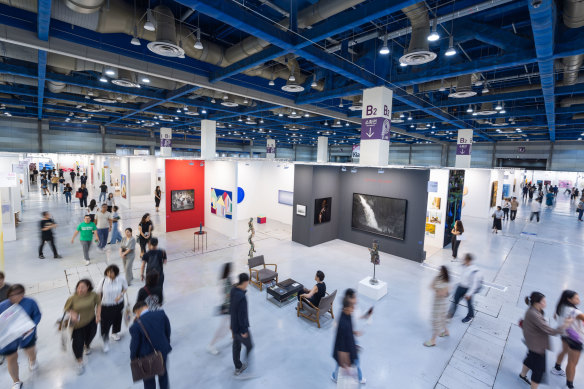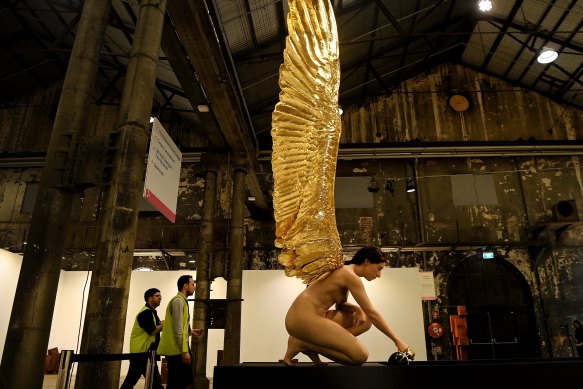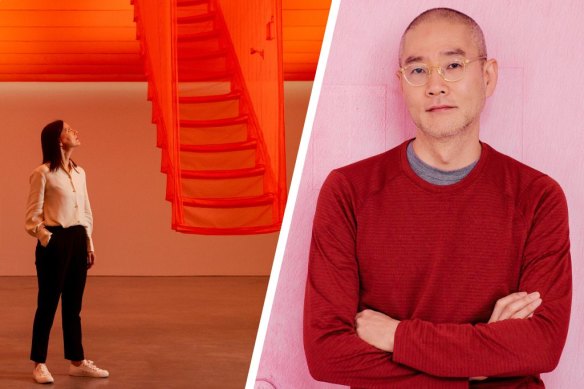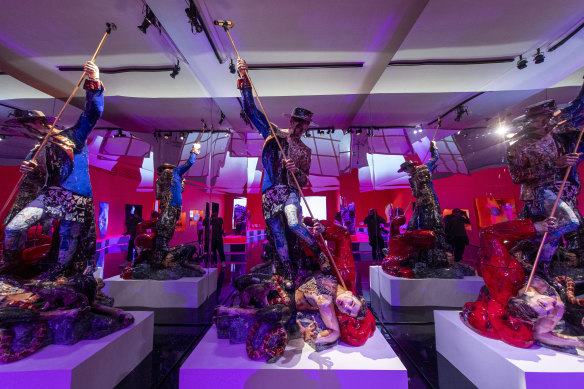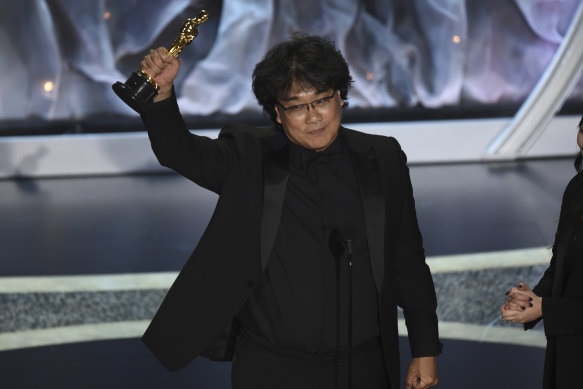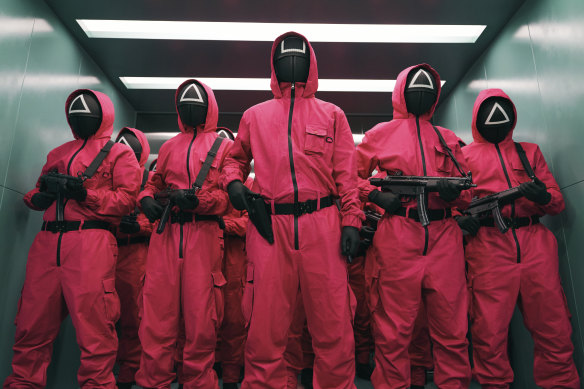Why Australia is destined to remain on the margins of international art
By John McDonald
Save articles for later
Add articles to your saved list and come back to them any time.
Last month, within 24 hours, I travelled from the Sydney Contemporary art fair to two fairs in South Korea: KIAF Seoul and Frieze Seoul. The contrast was striking, as are most cultural contrasts between Australia and South Korea.
Sydney Contemporary, celebrating its 10th anniversary, was held at Carriageworks over four days. It featured 96 galleries, with Australian dealers in the overwhelming majority. It attracted 25,000 visitors and generated sales of approximately $21 million.
KIAF – the Korean International Art Fair, which has been running since 2002, was held at the huge COEX centre in Seoul, alongside the inaugural edition of a second art fair, Seoul Frieze, a prestigious boutique event launched in London in 2003, and New York in 2012. The Koreans won the bid for the right to host the first Asian Frieze, as part of an ambitious campaign to become the centre of the Asian art market, a title usually assigned to Hong Kong.
The 2023 Korean International Art Fair.
KIAF, which featured 210 galleries, attracted 80,000 visitors over five days, while Frieze Seoul, with 121 galleries, managed 70,000 over four days. Combined sales were estimated at AUD $70 million.
Whoever coined the phrase, “comparisons are odious”, obviously had much to lose in this process. Comparisons between South Korea and Australia are enlightening because they show what can be achieved by an aspirational country with a strong commitment to art and culture. Australia can learn a great deal from South Korea’s investment in creativity as a soft power strategy that has raised the country’s international profile and generated billions in revenue.
When we consider South Korea has a population of 52 million against Australia’s 26 million, we might consider ourselves successful if we produce and earn half as much as they do. It’s obviously not a simple division by two because history, geography and other factors play significant roles in determining a nation’s character and productivity. Nevertheless, in allowing for Australia’s wealth and natural resources, alongside the Koreans we look like underachievers.
It’s not merely that the respective art fairs in Seoul attract 3-4 times as many visitors as Sydney Contemporary or enjoy 3-4 times the volume of sales. What’s notable is that South Korea is seen as a rapidly emerging centre of the international art market, whereas Australia remains on the margins. Frieze Seoul, for instance, had the full complement of Uber galleries that don’t find it worthwhile to travel to Sydney.
Sam Jinks’ Iris – The Messenger at Sydney Contemporary.Credit: Kate Geraghty
The Koreans have artists such as Do Ho Suh – recently featured at Sydney’s Museum of Contemporary Art – who is a much bigger star than any Australian artist, living or dead. Or Nam June Paik, recognised as the father of video art. Or Lee Ufan, whose work is being avidly collected by museums all around the world. Or Park Seo-bo, whose paintings are appearing in every international art fair. Kim Soo-ja has a huge installation at Sydney Modern, while Haegue Yang is being featured at the National Gallery of Australia.
South Korean galleries such as Hyundai, Kukje and Arario are fixtures at leading art fairs, in a way that no Australian gallery can match.
Earlier this year, a massive survey called Hallyu! The Korean Wave was featured at London’s Victoria and Albert Museum and given a very positive reception. Australia’s last foray into London was the shambolic exhibition imaginatively titled Australia, at the Royal Academy of Arts in 2013, for which responses ranged from lukewarm to scathing.
Korean artist Do Ho Suh recently had an exhibition at the Museum of Contemporary Art.Credit: Dominic Lorrimer, Daniel Dorsa
The comparison extends across the board, to the fields of cinema and literature. Australia currently has no director so widely celebrated as Bong Joon-ho, who won the 2020 Academy Award for Best Picture, with Parasite; let alone directors such as Park Chan-wook (Decision to Leave, 2022) (or Lee Chang-dong (Burning, 2018).
There were 11 Australian feature films released in 2022, as opposed to 58 Korean features. This is not counting those movies that were funded and completed, but never got a theatrical release. In Australia, this is the common fate of most local productions, in Korea it describes a small minority.
Last year, the Literature Translation Institute of Korea supported the publication of 150 works in 27 different languages. One of them – Bora Chung’s collection of gothic tales, Cursed Bunny, was shortlisted for the International Booker Prize – a prize won by Korea’s Han Kang in 2016, for The Vegetarian.
Artist Gwon O-sang’s painted sculpture Untitled G-Dragon, A Space of No Name on display during the V&A exhibition.Credit: Untitled
Perhaps the biggest Korean successes have been in the realm of popular culture, with TV series and pop music dominating the massive Asian market and reaching large audiences in other parts of the world.
Australia has had its pop culture export highlights. Soap operas such as Home and Away have been phenomenal, long-running successes, and there have been any number of bands and solo artists who have achieved big international followings, from AC/DC to Kylie Minogue.
Indeed, one of Tony Burke’s first initiatives as Minister for the Arts has been a $286 million commitment to the local music industry over four years. The visual arts are allegedly still on the drawing board.
Bong Joon Ho accepts the Oscar for best international feature film for Parasite.Credit: AP
This may sound like a huge investment, but in July last year, the incoming South Korean President, Yoon Suk-yeol, announced a $5.82 billion fund for the arts. It was a resounding endorsement for a cultural sector that allegedly generated $159.8 billion in sales in 2021, including exports to the value of $19.5 billion. In the same year, the entire Australian “arts and recreation” sector was valued at $15.2 billion by the Department of Foreign Affairs and Trade.
It’s worth noting that South Korea’s wholehearted investment in pop culture hasn’t had a negative impact on its traditional museums and art galleries. There are more than 100 in Seoul alone. In Sydney, there are less than 40 “museums”, with most being so small and obscure I defy anyone to name them all. In a city that is crying out for more, and more diverse, museums, we have watched the previous state government systematically undermine one of the leading institutions, the Powerhouse. Both the Powerhouse and Sydney Modern nowadays seem less interested in exhibitions than in hosting parties, functions and music events.
The lesson from Korea is that new initiatives do not have to arise at the expense of existing policies. Museums devoted to social history, applied arts, science and technology do not have to transform themselves into party venues to raise revenue – or simply be hip.
Another feature of Korean culture is the respect paid to senior artists. There is a museum in Seoul devoted to Kim Whanki (1913-74) a leading modernist who was one of the originators of the Tansaekwha or Monochrome school of painting, which was South Korea’s first distinctive contribution to 20th century art.
South Korean drama Squid Game. Credit: Netflix
In the Ho-Am Museum of Art at Yongin I saw a large retrospective of Kim’s work, charting his progression from small still lifes and landscapes to large abstract canvases. In the Busan Museum of Art there is a special wing devoted to the work of Lee Ufan (b.1936), incorporating paintings and sculptural installations. Lee is forever associated with the Mono-ha (ie. School of Things) movement that originated in Japan in the late 1960s. Today he is one of the top 10 artists in the world, with at least one Australian art museum currently planning a survey exhibition.
At the Art Sonje Center in Seoul, another large exhibition, My Name is Red, celebrated the work of Suh Youngsun (b.1951), an artist who represents the opposite pole of modern Korean art to the Minimalists. Suh is an expressionist, whose powerful paintings engage with “people, cities and history”. One might relate Suh’s work to the Minjung (“People’s”) movement that grew up after the notorious massacre in Gwangju in 1980, when the military government fired on protesters.
Minjung was also a reaction to the apolitical, disengaged nature of Monochrome painting, which had become highly collectible by the early 1980s. In modern Australian art, we see the same battles between figurative art and abstraction, but with none of the fire and passion brought about by the political and social upheavals that have forged post-war Korean society. The character of Korean culture owes a great deal to the legacy of Japanese imperialism, a brutal civil war, a post-war reconstruction that entailed enormous sacrifices and hardship, and a struggle between democracy and military dictatorship. Out of this seething cauldron has come a nation with a fierce pride in its own culture, and a desire to share these achievements with the rest of the world. In Australia, by comparison, we’ve had a pretty quiet time, with a stable political system and an utterly complacent attitude toward art and culture.
We can be thankful we don’t have Korea’s history but can learn a lot from the sense of urgency and importance with which they approach cultural matters. If there is a pay-off in terms of export dollars and international prestige, it’s a reward that has been earned by a level of commitment that has also seen departments of Korean studies and Korean Art being sponsored at international universities and museums.
In every area, we can see how a strategic investment in art and culture has allowed a country that is very far from being a superpower, to become a world leader. In Australia, we should realise that iron ore, coal and natural gas are never going to raise our international profile in the same way as creativity, imagination, and intellect. Industry and commerce will always be drivers of the economy, but for the sake of the future we need to take a lead from the Koreans and start investing in those human resources that can never be exhausted.
Find out the next TV, streaming series and movies to add to your must-sees. Get The Watchlist delivered every Thursday.
To read more from Spectrum, visit our page here.
Most Viewed in Culture
Source: Read Full Article
